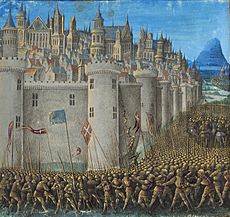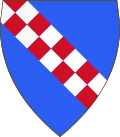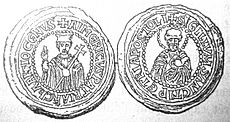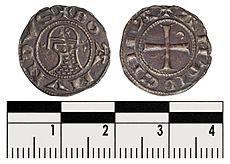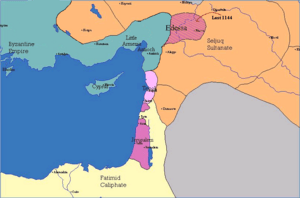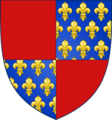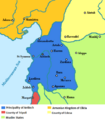Principality of Antioch facts for kids
Quick facts for kids
Principality of Antioch
|
|||||||||||
|---|---|---|---|---|---|---|---|---|---|---|---|
| 1098–1268 | |||||||||||
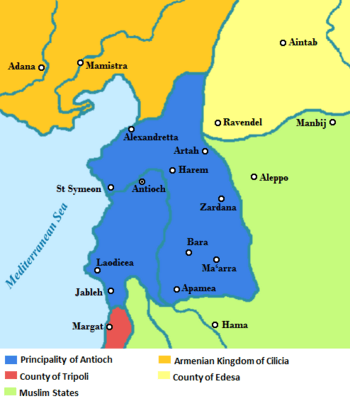
|
|||||||||||
| Status | Vassal of the Byzantine Empire (1138–1153, 1159–1183) Vassal of the Armenian Kingdom of Cilicia (1254–1260) Vassal of the Ilkhanate (1260–1268) |
||||||||||
| Capital | Antioch 36°12′17″N 36°10′54″E / 36.20472°N 36.18167°E |
||||||||||
| Common languages | Medieval Latin, Old Norman, Old French, Armenian, Aramaic, Greek, Arabic | ||||||||||
| Religion | Roman Catholicism (de jure) | ||||||||||
| Government | Feudal monarchy | ||||||||||
| Prince of Antioch | |||||||||||
|
• 1098–1111 (first)
|
Bohemond I | ||||||||||
|
• 1252–1268 (last)
|
Bohemond VI | ||||||||||
| Historical era | High Middle Ages | ||||||||||
|
• First Crusade
|
1098 | ||||||||||
|
• Conquered by the Mamluk Sultanate under Baibars
|
1268 | ||||||||||
|
|||||||||||
| Today part of | Turkey Syria |
||||||||||
The Principality of Antioch was one of the crusader states formed during the First Crusade. It was located in parts of what is now Turkey and Syria. This principality was smaller than other crusader states like the County of Edessa or the Kingdom of Jerusalem. It stretched along the northeastern coast of the Mediterranean Sea.
The principality bordered the County of Tripoli to the south and Edessa to the east. To the northwest, it bordered either the Byzantine Empire or the Armenian Kingdom of Cilicia, depending on the time period. In the 12th century, about 20,000 people lived there. Most were Armenians and Greek Orthodox Christians. Some Muslims lived outside the main city. Many of the crusaders who settled here came from Normandy or southern Italy. The first rulers were Normans and surrounded themselves with loyal followers. Most local people were not Roman Catholic, even though the city was under Catholic control.
Contents
History of Antioch
How Antioch Was Founded
While Baldwin of Boulogne went east to create the County of Edessa, the main Crusader army marched south. They began to besiege Antioch in October 1097. Antioch had been an important Byzantine city before the Seljuk Turks took it in 1084. The Crusaders, led by Bohemond of Taranto, besieged the city because it was very important for both strategy and religion.
Antioch had strong defenses with over 400 towers. The siege lasted through the winter, and many Crusaders suffered. They often had to eat their horses to survive. Bohemond convinced a guard named Firouz, an Armenian who used to be Christian, to let the Crusaders into the city. Just four days later, a Muslim army from Mosul, led by Kerbogha, arrived and began to besiege the Crusaders inside Antioch.
The Byzantine emperor, Alexios I Komnenos, was coming to help the Crusaders. However, he heard rumors that the city had fallen to the Muslims and turned back. The Crusaders managed to survive the siege. They were inspired by a mystic named Peter Bartholomew. Peter claimed that St. Andrew told him the Holy Lance, which pierced Christ's side, was in the city. They dug in the cathedral of St. Peter and Peter found the Lance himself. Even though some believed Peter might have hidden it there, it greatly boosted the Crusaders' spirits.
With the Holy Lance leading their army, Bohemond marched out to fight the Muslim forces. The Crusaders defeated them. Stories say an army of saints appeared to help them in battle. After the victory, there was a long argument about who should rule Antioch. Bohemond and the Italian Normans eventually won. Bohemond declared himself prince. He wanted his new land to be as independent as his lands in Italy. So, he did not seek a title from the Byzantine Emperor, which would have meant more duties. An unknown illness then spread through the Crusader camp, and many died.
Early Years of the Principality
In 1100, Bohemond was captured in battle. His nephew, Tancred, became regent (a temporary ruler). Tancred expanded Antioch's borders, taking cities like Tarsus and Latakia from the Byzantine Empire. However, these new lands were lost after the Battle of Harran. Bohemond was released in 1103 and went to Italy to gather more troops. Tancred remained regent.
In 1107, Bohemond used his new troops to attack the Byzantines. He was defeated in 1108 and forced to sign the Treaty of Devol. This treaty made Antioch a vassal state of the Byzantine Empire after Bohemond's death. Bohemond had promised to return any land taken from Muslims to the Byzantines when the Crusaders passed through Constantinople in 1097. Bohemond also fought alongside Baldwin and Joscelin at Aleppo. When Baldwin and Joscelin were captured, Tancred also became regent of Edessa. Bohemond left Tancred as regent again and returned to Italy, where he died in 1111.
The Byzantine emperor wanted Tancred to return Antioch to Byzantium. But Tancred was supported by the County of Tripoli and the Kingdom of Jerusalem. Tancred had been the only Crusader leader who did not promise to return conquered land to the emperor. Tancred died in 1112. He was succeeded by Bohemond II, with Tancred's nephew Roger of Salerno as regent. Roger defeated a Seljuk attack in 1113.
On June 27, 1119, Roger was killed at the Ager Sanguinis (Field of Blood). Antioch then became a vassal state of Jerusalem. King Baldwin II became regent until 1126. Bohemond II married Baldwin's daughter Alice and ruled for only four years. The Principality was then inherited by his young daughter Constance. Baldwin II was regent again until his death in 1131, when Fulk of Jerusalem took over. In 1136, Constance, who was only 10, married Raymond of Poitiers, who was 36.
Raymond, like previous rulers, attacked the Byzantine province of Cilicia. This time, Emperor John II Komnenos fought back. He arrived in Antioch in 1138 and forced Raymond to promise loyalty to him. Then, John led a combined army of Byzantines, Antioch, and Edessa against Muslim Syria. They captured several fortresses. However, Raymond and Joscelin II of Edessa did not fully help John during the Siege of Shaizar. The city was taken, but its main fortress remained. The ruler of Shaizar offered to pay a large sum and become John's vassal. John accepted this offer. When the army returned to Antioch, a riot started, forcing the emperor to leave without taking the fortress. John planned to conquer Antioch and rule over the other Crusader states, but he died in 1143.
Antioch and the Byzantine Empire
After the fall of Edessa in 1144, Nur ad-Din attacked Antioch during the Second Crusade. Much of the eastern part of the Principality was lost. Raymond was killed at the battle of Inab in 1149. Baldwin III of Jerusalem was regent for Raymond's widow, Constance, until 1153. She then married Raynald of Châtillon.
Raynald immediately clashed with the Byzantines in Cyprus. He made peace with Manuel I Comnenus in 1158. The next year, Manuel arrived to take control of the Principality. From then on, Antioch became a vassal of Byzantium until Manuel's death in 1180. This meant Antioch had to send troops to the Byzantine Army. For example, soldiers from Antioch fought against the Seljuk Turks in 1176. This alliance also protected Antioch from Nur ad-Din when the city was in great danger.
Raynald was captured by Muslims in 1160. The Patriarch of Antioch became regent. Raynald was not released until 1176 and never returned to Antioch. Meanwhile, Manuel married Constance's daughter Maria. But Constance was removed from power in 1163 and replaced by her son Bohemond III. Bohemond was captured by Nur ad-Din the next year at the Battle of Harim. The Orontes River then became the permanent border between Antioch and Aleppo. Bohemond returned to Antioch in 1165 and married one of Manuel's nieces. He also agreed to have a Greek Orthodox patriarch in the city.
The alliance with Byzantium ended when Emperor Manuel died in 1180. Antioch lost the Empire's protection, which had kept Nur ad-Din away for twenty years. However, with help from Italian city-state fleets, Antioch survived Saladin's attack on the Kingdom of Jerusalem in 1187. Neither Antioch nor Tripoli took part in the Third Crusade. However, the remains of Frederick Barbarossa's army briefly stopped in Antioch in 1190 to bury their king. Bohemond III's son, also named Bohemond, became count of Tripoli. Bohemond III's oldest son Raymond married an Armenian princess in 1194. Bohemond III died in 1201.
Bohemond's death led to a power struggle between Antioch, led by Bohemond of Tripoli, and Armenia, led by Bohemond III's grandson Raymond-Roupen. Bohemond of Tripoli, known as Bohemond IV, took control by 1207. But Raymond briefly ruled as a rival from 1216 to 1219. Bohemond IV died in 1233. Antioch, then ruled by his son Bohemond V, did not play a major role in later Crusades.
Relations with Other Latin Settlements
The Principality's relationship with other Latin settlements was shaped by two things. First, the Princes of Antioch wanted to expand their power, which sometimes caused conflict with the County of Edessa and the Kingdom of Jerusalem. Second, the Latin rulers formed alliances because they all faced similar challenges in the East. These alliances were strengthened by feudal ties and marriages between the ruling families.
Baldwin of Boulogne, Count of Edessa, and Bohemond I were said to have a relationship based on equality. For example, they traveled to Jerusalem together in 1099. They also helped appoint Latin bishops in Antioch and Edessa. Bohemond I and Baldwin of Le Bourcq also had a close relationship; Baldwin was made commander of Antioch's army by Bohemond in 1100.
However, relations were sometimes difficult between Antioch and Tripoli, especially under Raymond, Count of Toulouse. Raymond allied with Emperor Alexius I Commnenus instead of Bohemond. In 1105, Bohemond left the East and put his nephew, Tancred, in charge of Antioch. In 1108, Bohemond also put Richard of Salerno in charge of Edessa. But Tancred was unwilling to give it up because he and Baldwin were fighting for control of Edessa. This conflict continued into 1109. At the same time, a conflict between Antioch and the Count of Tripoli, William-Jordan, was resolved. William-Jordan agreed to give up Tripoli in exchange for keeping Toulouse. Bertrand of Toulouse then allied with Baldwin I of Jerusalem. In 1110, a council met after William-Jordan was killed. After this, Antioch and Edessa seemed to make peace.
In 1111, when the Muslim army of Maudud of Mosul threatened Antioch, its Latin allies sent military help. In 1112, Bertrand of Toulouse died, and Roger Salerno took over Edessa. During this time, the relationship between Antioch, Edessa, and the Kingdom of Jerusalem improved. For example, in 1115, the Edessene part of the army was crucial to Antioch's army before the Battle of Tell Danith. In 1118, the forces of Jerusalem, Antioch, and Tripoli combined to face an army from Egypt and Damascus that was threatening Jerusalem.
But in 1119, Roger of Salerno was killed, leaving no adult heir. This changed the balance of power in northern Syria. Baldwin II, King of Jerusalem, was appointed Regent. At this time, Joscelin of Courtenay had stable rule in Edessa, which further weakened Antioch's power in Northern Syria. In 1126, Bohemond II arrived in the East. Baldwin wanted Antioch and Jerusalem to stay close, so he arranged a marriage between the Prince of Antioch and his daughter, Alice. In 1127, a dispute between Bohemond and Joscelin of Courtenay led to Joscelin raiding Antioch. In 1130, a crisis over who would rule followed Bohemond II's death. This marked the end of Antioch's strong influence in northern Syria.
The Fall of the Principality

In 1254, Bohemond VI married Sibylla of Armenia. This ended the power struggle between the two states. However, by this time, Armenia was stronger, and Antioch was mostly a vassal state. Both were caught in the conflict between the Mameluks and the Mongols. In 1260, influenced by his father-in-law, the Armenian king Hetoum I, Bohemond VI submitted to the Mongols under Hulagu. This made Antioch a state that paid tribute to the Mongol Empire. Bohemond and Hetoum fought with the Mongols during their conquests of Muslim Syria, taking the cities of Aleppo and later Damascus.
When the Mongols were defeated at the Battle of Ain Jalut in 1260, Baibars, the Mamluk sultan of Egypt, began to threaten Antioch. Antioch had supported the Mongols as a vassal of the Armenians. Baibars finally captured the city in 1268. All of northern Syria was quickly lost. Twenty-three years later, Acre was taken, and the Crusader states no longer existed.
An Armenian writer named Toros Roslin described the brutal attack on Antioch by Baibars in 1268. He wrote that many people were killed or taken prisoner, and the beautiful churches were destroyed by fire. After the fall of Antioch, the title "Prince of Antioch" passed to the kings of Cyprus. It was sometimes given to younger members of the royal family.
People of Antioch
The people living in the Principality were quite diverse. A large number were Armenian Christians. They lived in Antioch and in other towns and rural areas. Some historians believe they were the largest ethnic group. There were also other Christian groups, including Aramaic-speaking Syriacs and Arabic-speaking Melkites. Muslims also lived in the capital city and in the southern and eastern parts of the principality. There were also Greeks and Jews.
Images for kids
See also
 In Spanish: Principado de Antioquía para niños
In Spanish: Principado de Antioquía para niños






